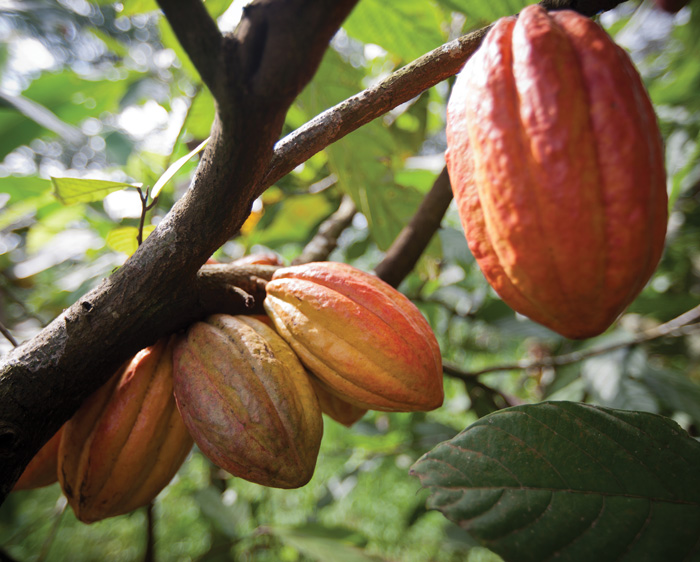Sweetening the Chocolate Pot
Ingredients | APPLIED SCIENCE
Chocolate products are offering more ways than ever to connect with a wealth of on-trend consumer demands. Taste is still tops, of course, but chocolate makers are sweetening the pot by wooing shoppers with sensory delights that can also tout attributes like fair trade, sustainable, clean label, plant-based, less sugar, healthy, premium, and more.
And chocolate consumers around the world know what they want: 83% agree that chocolate needs to be “tasty and good for me,” 67% say they want to know more about where their chocolate comes from and what is in it, and 75% are looking to try new and exciting chocolate experiences, according to a 2019 proprietary study from Barry Callebaut.
“We see two big growth drivers for chocolate confectionery globally, which are also accelerating in the United States, ‘intense indulgence’ and ‘mindful indulgence,’” says Charlotte Green, manager, market segment development at Barry Callebaut.
Fortune Business Insights reports that globally, the cocoa and chocolate market should jump from a projected $48.3 billion in 2022 to $67.9 billion by 2029, a compound annual growth rate (CAGR) of almost 5%. In the United States, “chocolate sales increased 9.4% in the latest 52 weeks to reach $17.2 billion, per IRI data,” says Heidi Liu, product line manager at Blommer Chocolate Co.
Plant-based is one of the hottest product development areas for chocolate, and it’s expected to become a $1.4 billion global market by 2028, according to Grand View Research. Product availability for milk chocolate alternatives is struggling to keep up with demand, but major chocolate players are cooking up new offerings. Mars has rolled out its CO2COA “animal free dairy” chocolate bar, Hershey is testing oat milk bars in Classic Dark and Extra Creamy Almond & Sea Salt flavors, and Cargill Cocoa & Chocolate unveiled its new ExtraVeganZa vegan chocolate ingredient in Europe in 2021.
Rx Chocolate
Chocolate is a perfect fit for the growing number of consumers craving healthy, functional sweet treats. For example, results published earlier this year from COSMOS, the first large-scale trial to test cardiovascular benefits of cocoa flavanols, suggest that long-term use may help reduce cardiovascular risk, including a 27% reduction in cardiovascular death.
Nearly 70% of consumers already believe chocolate has health benefits, according to Cargill’s 2021 ChocoLogic research. “[Consumers] are also looking for new, healthier versions of chocolate, whether they be reduced or no-sugar, plant-based, increased cocoa percentage, or added protein,” says Drew Brandell-Mayers, product manager-chocolate at Puratos USA.
Ingredients that help reduce sugar or allergens, such as allulose and oat milk, are increasing among new chocolate confectioneries launched during 2020–2022, according to Mintel GNPD.
Sweet Sustainability
More than 1 in 2 U.S. consumers are willing to pay a little more for chocolate with a “sustainable” claim, according to Barry Callebaut data. Chocolate companies continue to be in the forefront of environmentally friendly innovation:
- Barry Callebaut’s WholeFruit Chocolate includes both beans and pulp from the cacao fruit, using parts of the fruit normally discarded as waste.
- U.S. startup California Cultured is developing cocoa nibs cultured from cacao plant stem cells, while Planet A Foods in Germany is fermenting androasting oats to produce new Nocoa, a cocoa-free cocoa butter.
- Cargill has partnered with vertical farming pioneer AeroFarms to research indoor growing technologies that enable more climate-resilient cacao tree farming practices.
Chocolate Glossary
Bittersweet*—chocolate liquor (not less than 35% by weight) and nutritive carbohydrate sweetener(s)
Cacao/Cacao bean—raw, unprocessed seed from which cocoa and chocolate are made
Cacao fruit—pod-shaped fruit that produces approximately 35–50 seeds surrounded by a sweet pulp; also Cocoa fruit
Cacao nib*—small piece of cured, cleaned, dried, and cracked cacao beans with the shell removed; also Cocoa nib
Cacao powder—bitter powder milled from cacao beans processed at low temperatures
Cacao pulp—soft, sweet substance that surrounds cacao beans in cacao fruit
Chocolate liquor*—solid or semiplastic ingredient made by finely grinding cacao nibs; also Unsweetened
Cocoa/Cocoa powder—highly concentrated, processed powder made from paste of cocoa beans
Cocoa bean—dried, fully fermented seed of Theobroma cacao; three main varieties are Criollo, Forastero, Trinitario
Cocoa butter—pale-yellow fat extracted from cocoa beans
Dark—chocolate liquor and nutritive carbohydrate sweetener(s)
Dutch processed cocoa—cocoa solids treated with an alkalizing agent to reduce natural acidity, making the cocoa darker and less bitter; also Alkalized cocoa
Milk chocolate*—chocolate liquor (not less than 10% by weight), dairy ingredient(s), and nutritive carbohydrate(s)
Ruby chocolate—naturally pink-colored chocolate with fruity taste made from Ruby cocoa beans
Semisweet*—chocolate liquor (not less than 35% by weight) and nutritive carbohydrate sweetener(s)
Single-origin—made from cocoa beans from a single source, such as a plantation, country, or region
Sweet*—chocolate liquor (not less than 15% by weight) and nutritive carbohydrate sweetener(s)
White chocolate*—mixed and ground cacao fat, dairy ingredient(s), and nutritive carbohydrate sweetener(s) free of coloring material
* Code of Federal Regulations Part 163 – Cacao Products; last amended 9/15/2022
To view the full article with infographics , please download the pdf.




